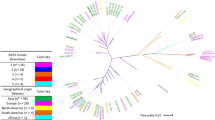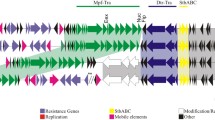Abstract
Thirty-four strains belonging to various species of the genusThermus (T. aquaticus, “T. thermophilus,” “T. brockianus,” T. scotoductus, and genomic species 2) isolated from hot springs of different geographical areas were examined for plasmid content and restriction fragment length polymorphism (RFLP) of plasmid DNAs. The four strains of the numerical taxonomy cluster E of genomic species 2 did not harbor plasmid DNA. Overall examination of theHindIII-RFLP profiling of plasmid DNA showed considerable variability between and within genomic species, with the exception of presumed clonal isolated. In spite of this heterogeneity,HindIII plasmid digests within a numerical taxonomic cluster gave a subset of restriction fragments of similar or identical length. Strains belonging to genomic species 2 or unclassified isolates from S. Pedro do Sul that harbored plasmid DNA (7 of the 14 strains studied) exhibited strong DNA homology between plasmid regions. No homologous sequences to these plasmid regions were found in chromosomal DNA from strains isolated from S. Pedro do Sul in which no plasmids were detected. The strains belonging toT. scotoductus formed two plasmid DNA homology groups, as estimated by probing with a plasmid fragment that coincided with the two numerical taxonomy clusters proposed previously. Among the other species, homology of plasmid regions was also found between some strains. Strong homology was also found between plasmid regions from some strains of different taxonomic groups, isolated from the same and from different sources, suggesting that these sequences are highly conserved in plasmids present inThermus. For plasmid-containing strains, results of plasmid RFLP profiling/DNA homology appear promising for the typing ofThermus at the level of biotypes or of individual strains, namely, for monitoring the diversity and frequency of isolates from a particular hot spring.
Similar content being viewed by others
References
Becker RJ, Becker DA, Starzyk J (1986) Bacteriocin-like activity within the genusThermus. Appl Environ Microbiol 52:1203–1205
Birnboim HC, Doly J (1979) A rapid alkaline extraction procedure for screening plasmid DNA. Nucleic Acids Res 7:1513–1523
Brock TD (1978) Thermophilic microorganisms and life at high temperatures. Springer, Berlin Heidelberg New York
Brock TD, Freeze H (1969)Thermus aquaticus gen. nov. and sp. nov., a non-sporulating extreme thermophile. J Bacteriol 98:289–297
Earnshaw R, Gidley J (1992) Molecular methods for typing bacterial food pathogens. Trends Food Sci Technol 3:39–42
Goldberg JB, Ohman DE (1984) Cloning and expression inPseudomonas aeruginosa of a gene involved in the production of alginate. J Bacteriol 158:1115–1121
Hishinuma F, Tanaka T, Sakaguchi K (1978) Isolation of extrachromosomal deoxyribonucleic acids from extremely thermophilic bacteria. J Gen Microbiol 104:193–199
Hudson JA, Morgan H, Daniel RM (1987)Thermus filiformis sp. nov., a filamentous caldoactive bacterium. Int J Syst Bacteriol 37:431–436
King GJ (1989) Plasmid analysis and variation inPseudomonas syringae. J Appl Bacteriol 67:489–496
Kristjansson JK, Alfredsson GA (1983) Distribution ofThermus spp. in Icelandic hot springs and a thermal gradient. Appl Environ Microbiol 45:1785–1798
Kristjansson JK, Hjorleifsdottir S, Marteinsson VT, Alfredsson GA (1994)Thermus scotoductus, sp. nov., a pigment-producing thermophilic bacterium from hot tap water in Iceland and includingThermus sp. X-1. Syst Appl Microbiol 17:44–50
Lazo GR, Gabriel DW (1987) Conservation of plasmid DNA sequences and pathovar identification of strains ofXanthomonas campestris. Phytopathology 77:448–453
Mather MM, Fee JA (1990) Plasmid-associated aggregation in“Thermus thermophilus” HB-8. Plasmid 24:45–56
Munster MJ, Munster AP, Sharp RJ (1985) Incidence of plasmids inThermus spp. isolated in Yellowstone National Park. Appl Environ Microbiol 50:1325–1327
Munster MJ, Munster AP, Woodrow JR, Sharp RJ (1986) Isolation and preliminary taxonomic studies ofThermus strains isolated from Yellowstone National Park, USA. J Gen Microbiol 132:1677–1683
Olsen JE, Larsen JL (1990) Restriction fragment length polymorphism of theVibrio anguillarum Serovar O1 virulence plasmids. Appl Environ Microbiol 56:3130–3132
Oshima T, Imahori K (1974) Description of“Thermus thermophilus” (Yoshida and Oshima) comb. nov., a nonsporulating thermophilic bacterium from a Japanese thermal spa. Int J Syst Bacteriol 24:102–112
Pask-Hughes RA, Williams RAD (1977) Yellow-pigmented strains ofThermus spp. from Icelandic hot springs. J Bacteriol 102:375–383
Platt DJ, Taggart J, Heraghty KA (1988) Molecular divergence of the serotype-specific plasmid (pSLT) among strains ofSalmonella typhimurium of human and veterinary origin and comparison of pSLT with the serotype-specific plasmids ofS. enteriditis andS. dublin. J Med Microbiol 27:277–284
Raven NDH, Williams RAD (1989) Isolation and characterization of plasmids present inThermus strains from Yellowstone National Park. In: Da Costa MS, Duarte L, Williams RAD (eds) Microbiology of extreme environments and its potential for biotechnology. Elsevier, London, pp 44–61
Saiki T, Kimura R, Arima K (1972) Isolation and characterization of extremely thermophilic bacteria from hot springs. Agric Biol Chem 36:2357–2366
Sambrook J, Fritsch EF, Maniatis T (1989) Molecular cloning. A laboratory manual, 2nd edn. Cold Spring Harbor Laboratory Press, Cold Spring Harbor
Santos MA, Williams RAD, Da Costa MS (1989) Numerical taxonomy ofThermus isolates from hot springs in Portugal. Syst Appl Microbiol 12:310–315
Stahl S (1991) Plasmids inBacillus stearothermophilus coding for bacteriocinogeny and temperature resistance. Plasmid 26:94–107
Tenreiro S, Nobre MF, Hoste B, Gillis M, Kristjansson JK, Da Costa MS (1995) DNA-DNA hybridization and chemotaxonomic studies ofThermus scotoductus. Res Microbiol (in press)
Vásquez C, Villanueva J, Vicuña R (1983) Plasmid curing in“Thermus thermophilus” and“Thermus flavus”. FEBS Lett 158:339–342
Williams RAD (1989) Biochemical taxonomy of the genusThermus. In: Da Costa MS, Duarte LC, Williams RAD (eds) Microbiology of extreme environments and its potential for biotechnology. Elsevier, London, pp 82–97
Williams RAD, Da Costa MS (1992) The genusThermus and related organisms. In: Balows A, Truper HG, Dworkin M, Harder W, Schleifer KH (eds) The prokaryotes: a handbook on the biology of bacteria: ecophysiology, isolation, identification, applications, 2nd edn. Springer, Berlin Heidelberg New York, pp 3745–3753
Author information
Authors and Affiliations
Rights and permissions
About this article
Cite this article
Moreira, L.M., Da Costa, M.S. & Sá-Correia, I. Plasmid RFLP profiling and DNA homology inThermus isolated from hot springs of different geographical areas. Arch. Microbiol. 164, 7–15 (1995). https://doi.org/10.1007/BF02568728
Received:
Accepted:
Issue Date:
DOI: https://doi.org/10.1007/BF02568728




